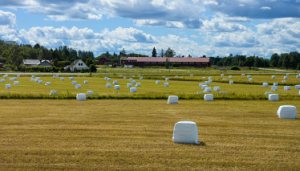Getting the Edge in Baling with Silage Film
Silage film is used in the agro-industry to store silage, hay, and other forage crops. This material is highly breathable and maintains the freshness of forage. It is also recyclable. This film is used to protect the bales from moisture and insects. Available in several colours, silage film is usually 20 to 25-micron thick and available in rolls up to 10 inches wide.
 Polyethylene is the main constituent of silage film, but most types are synthetic. One example of a silage film manufactured by SML is a five-layer extrusion film made from 100% ExxonMobil PE. This film has good oxygen barrier properties, while porous films are permeable, allowing air to pass through. SML manufactures both types of silage film. Using this technology, manufacturers can increase production capacity and profitability by utilizing fewer raw materials.
Polyethylene is the main constituent of silage film, but most types are synthetic. One example of a silage film manufactured by SML is a five-layer extrusion film made from 100% ExxonMobil PE. This film has good oxygen barrier properties, while porous films are permeable, allowing air to pass through. SML manufactures both types of silage film. Using this technology, manufacturers can increase production capacity and profitability by utilizing fewer raw materials.
SilageWrap silage film offers an extensive portfolio of agricultural film solutions for all applications. The company collaborates with the agricultural industry to design advanced solutions that protect forage and the ecosystem. Its innovative solutions are highly durable and environmentally friendly. The company is proud to support farmers with innovative products and services throughout the food value chain. Its silage film solutions are geared toward helping Indian farmers meet their needs. You can learn more about its latest agricultural films here. You’ll be glad you chose SABIC.
The main advantages of silage film include its ability to reduce spoilage of forage while maintaining the nutritional value of the feed. In addition, it is easy to handle, provides UV protection, and has superior sealing properties. The product is produced from premium-grade polythene and is available in various colours. Silage film is also available in white, blue, and red. There are three main types of films used for the storage of forage.
Another advantage of silage plastic film is its elasticity. It can last longer than traditional bale wraps, which is a significant advantage for farmers. Silage wraps can also last longer than traditional bale wraps. Silage film is also more durable than propeller thread, which is natural fibrous and can break if exposed to the elements. It also offers better protection against sunlight. You can use it for any number of applications, including covering the space between bales.
Choosing the suitable silage wrap is crucial to the success of your silage baling process. Not all films are created equal. One should select one with the right thickness and a few with multiple layers to prevent punctures. The thickness of silage wrap should be 1.5 millimetres thick. In addition, it should be applied to the bale within 24 hours of baling, as oxygen may cause the fermentation process.
Before wrapping the bales, ensure that the ground beneath is free from stubble or other plants. Preparing the ground below the bales is crucial to prevent holes in the plastic. If this is not possible, use an underlay of used bale wrap for additional protection. Another critical point is to keep the silage film from being damaged by UV rays. Strong UV-rays attack plastic, resulting in solid feed heating, which reduces the quality of the product.
While the silage film industry is relatively new, it is expected to gain popularity in the future. More sustainable biofuels are expected to become the norm with increased awareness of the effects of fossil fuels on the environment. By choosing the proper film, you can preserve the nutritional content of the bale. So, if you’re a farmer who grows silage, consider investing in silage wrap films. Please don’t wait for the market to saturate itself with these films. All the best, and Happy Baling
Aside from being durable and resistant to tearing, the high-quality SiloPro from Visqueen Polycrop is also easy to use and affordable. It has excellent mechanical strength and durability and is suitable for use in complex machinery. Its reduced thickness and UV stability make it an excellent choice for all baling applications. The film’s UV-stabilised surface also makes it perfect for wrapping silage. These factors make the product suitable for many applications and essential for high-quality hay.
